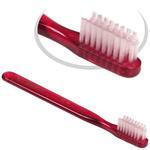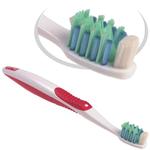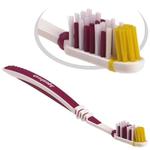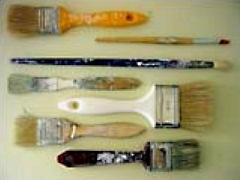Mouthful of Systematic Innovation
The Six Thinking Tools for Predicting New Products
Published in TheMarker magazine, August
7, 2000
Author: Ari
Manor, CEO, ZOOZ
Part IV
G. "Adjustment to the Environment" of the Toothbrush
"Adjustment to the Environment", the last of the 6 thinking tools, is less strict and formal than the other tools, and is more flexible and open to interpretation. It is also highly productive, second only to "Adding a Dimension".
"Adjustment to the Environment" focuses on the components found in the product’s nearby environment (e.g. - sink, hand, teeth, plaque, microbes, gums, mouth, eyes, mirror, water, etc.). When using this thinking tool, one tries to improve the quality of interaction between the product and its environment.
This pattern is evident in the following toothbrush innovations (the involved environment components are
underlined):
1.
Flexible handle neck that bends to absorb excess pressure, reducing the risk of
gum damage
2. Non-slip handle (e.g. - with rubber coating or protrusions) for firmer hand grip and greater brush control
3. Orthodontic toothbrush (with "V"-trim bristles) for effective cleaning around
braces.
4.
Micro-Texture bristles - for more effective plaque removal
(involving the sides of the bristle, not only the edges)



"V"-trim bristles | Non-slip handle | Flexible neck
Future toothbrush innovations following this pattern (Adjustment to the Environment) may include:
1. Arc-shape bristle surface for better contact with the back teeth.
2. Gum-brush (soft bristles, narrow head, and perhaps roller-like head) for massaging and stimulating the
gums.
3. Built-in
water or mouthwash tank - to enable convenient usage
of the toothbrush outdoors (away from water taps).
4. Built-in chlorhexidine tank - to sterilize the bristles after brushing (decreasing damage caused by microbes
)
_________________________________________________________
H. Concluding Remarks
This article demonstrates the 6 thinking tools that are used for the Systematic Innovation of products (toothbrushes in this case). The first tool, Adding a Dimension, links between variables related to the products. The last tool, Environmental Adjustment, improves the interaction with components of the nearby environment. The other 4 thinking tools - Distribution, Duplication, Reduction, and Unification - manipulate the product components.
Following are some concluding remarks:
- The discussed thinking tools can be used for predicting many other future toothbrush innovations. E.g. - use toothbrush variables that are not mentioned above, and see if you can add new dimensions.
- Note that identical ideas can stem from different thinking tools. E.g. - While "Arc shape bristle surface" is an adjustment to the back teeth, it also forms a new dependency between the length of the head and the length of the bristle (= ads a dimension).
- The described innovations used only components and variables of the product and its nearby environment. The further away from the product we look, the less innovative ideas we find. This principle is known as the "closed world" principle.
- Conservative products (that did not change much over the last decades) yield more ideas for innovation than mature products (that underwent many changes). The toothbrush is a relatively mature product, so if your product is more conservative expect many more ideas for innovation.
- Systematic Innovation first creates a new product form, and only then asks what it is good for. Sometimes you find no benefit at all (bristles-less brush? Who will buy it?). Other times you will find many different benefits (a Finger Brush offers better control and reach, saves space, and cuts costs). In the latter case, you should identify the most promising benefit (e.g. - the benefit that will yield higher sales), and position the new product around this benefit.
- While this article related to products, Systematic Innovation works great with services as well. In fact, services benefit more quickly from Systematic Innovation. Changing a service (e.g. - a savings plan) usually takes less time and also costs less than changing a production line routine.
- Systematic Innovation is systematic in two ways. First, it uses very precise idea generation procedures (the full procedures are not within the scope of this article). Second, and much more important, combining all 6 thinking tools is shown to predict, in many cases, most of the innovations that will appear in the coming few years. In other words, the idea screening is systematic and comprehensive, as opposed to many random creativity techniques.
This article offers a bird's eye perspective of Systematic Innovation. Further learning and training is vital in order to understand and command each of the thinking tools (see other articles). One good way to learn the method is to try it out on your own products. Thus, you will not only deal with more relevant products (unless you are a toothbrush manufacturer...), but will also result in practical ideas for new products and services in your own field.
For your convenience, we offer in-house Systematic
Innovation workshops anywhere on the globe. During such workshops participants learn to apply the various Thinking Tools while focusing on their own products and services, and typically produce dozens of useful ideas for innovation.
For information about
Systematic Innovation workshops click here,
or contact us.
Also, feel free to send us your comments, suggestions, and questions.
------------------------------------------------------------------------
Writen by Ari Manor, CEO, ZOOZ. All rights reserved.
Any trademarks and symbol-marks used in this article belong to their owners.
Other articles on this subject:
Detailed articles on one of the thinking tools:
1. Adding a
Dimension
2. Adjustment to the Environment
References:
1.
Goldenberg, J., Mazursky, D., & Solomon, S. 1999. Toward
Identifying the Inventive templates of New Products: A Channeled
Ideation Approach. Journal of Marketing Research, 36, 200-210.
2. Goldenberg, J., & Mazursky, D.
The Voice of the Product: Templates of New Product
Emergence. Creativity and Innovation Management, 8, 3, 157-164.
3. Goldenberg, Y., Solomon, S.,
& Mazursky, D. 1996. Cluster Concept dynamics Leading to Creative
Ideas without Critical Slowing Down. International Journal of Modern
Physics C, 7, 5, 655-673.
4. Altschuler, Genrich
S. (1986), To find an idea: Introduction to the theory of solving
problems of inventions, Novosibirsk, USSR, Nauka.
5. Altschuler, Genrich
S. (1985), Creativity as an
Exact Science, New York, Gordon and Breach.





